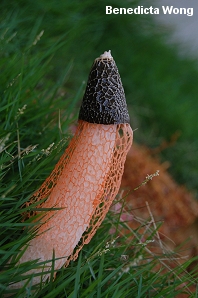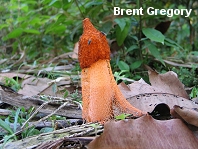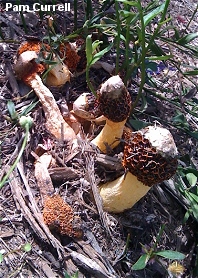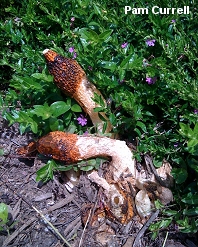| Major Groups > Stinkhorns > Phallus cinnabarinus |

|
Phallus cinnabarinus [ Basidiomycota > Agaricomycetes > Phallales > Phallaceae > Phallus . . . ] by Michael Kuo A flashy version of Phallus indusiatus with a cinnabar red (rather than white) skirt, this gorgeous stinkhorn is recorded from Asia, Australia, Hawaii, Central America, South America, and southern Mexico. The cap is initially covered with brown to olive-brown, spore-packed goo—but as flies and other insects remove the material the cinnabar surface of the cap is revealed. I have never collected Phallus cinnabarinus, and I have never studied material collected by others. If you have found this amazing mushroom, I would love to make this page more scientific by studying your specimen! Please send me an email at if you would be interested in preserving the mushroom and sending it for study. Dictyophora cinnabarina is a synonym, as is Dictyophora indusiata f. rosea in the sense of Guzmán, Montoya & Bandala (1990). Description: Ecology: Saprobic; growing alone or gregariously in woods and in urban settings; appearing year-round; distributed in North America from roughly the 24th parallel southward (southern Mexico); also common throughout the tropics, nearly world-wide (but possibly absent in Africa). Immature Fruiting Body: Like a whitish to yellowish "egg" attached, at the base, to pinkish rhizomorphs; when sliced revealing the stinkhorn-to-be encased in a gelatinous substance. Mature Fruiting Body: Cylindric and phallic, to about 20 cm high, with a clearly differentiated head structure that sits atop the stem, and an ample netted structure hanging from the bottom of the head. Head: To about 6 cm high; conic to broadly conic or bell-shaped; often becoming perforated at the apex; pitted and pocketed in a reticulate pattern; surface reddish orange, but covered with a thick layer of dark olive brown spore slime that eventually wears off (or is carried away by flies). Stem: To about 15 cm high and 2 cm wide; more or less equal; dry; whitish to pinkish or very pale orange; coarsely pocked; hollow; base enclosed in a whitish to yellowish volva. Indusium (Net): Usually extending nearly to the ground; reddish orange; widely reticulate. Odor: Unpleasant. Microscopic Features: Spores 3–4 x 1.5–2 µm; elongated-ellipsoid to nearly cylindric; smooth; brown in KOH. Sphaerocysts of the pseudostipe 40–70 µm wide; subglobose. Hyphae of the volva 2–3 µm wide; clamp connections present. REFERENCES: (Lee, 1957) Kreisel, 1996. (Guzmán, Montoya & Bandala, 1990; Hemmes & Desjardin, 2002; Calonge, 2005; Abrar et al., 2007; Hemmes & Desjardin, 2009; Hosaka, 2010; Gogoi & Parkash, 2014; Cabral et al., 2015; Hawkeswood, 2019a; Hawkeswood, 2019b.) I have not collected this mushroom. This site contains no information about the edibility or toxicity of mushrooms. |
© MushroomExpert.Com |
|
Cite this page as: Kuo, M. (2021, September). Phallus cinnabarinus. Retrieved from the MushroomExpert.Com Web site: http://www.mushroomexpert.com/phallus_cinnabarinus.html |



